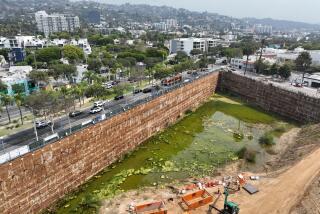<i> Underground Vapor at Manhattan Village </i> : New Tests Find Near-Explosive Methane
- Share via
MANHATTAN BEACH — The Manhattan village project sits atop a deep underground aquifer that supplies about 15% of the city’s drinking water.
Methane vapors have reached near-explosive levels at the Manhattan Village development site, a new test showed Wednesday.
The underground vapors were found at the site of a proposed golf course and two blocks from a complex of 160 homes and condominiums. But they pose no threat to the homes, according to Carl Abel, director of Manhattan Beach Public Services. The development also includes a mall, which has already been built.
The underground vapors previously tested out at 10,000 parts per million--well below the 53,000 ppm explosive level for methane. But those tests were taken with equipment that can register no higher than 10,000 ppm. New tests, conducted with more sophisticated devices, show the fumes peaking at 51,000 ppm on portions of the proposed golf course, according to Abel.
A level of 51,000 ppm was found in one 50-feet-deep vapor well near the center of the site, and levels of 20,000 ppm were found at another well closer to the homes that earlier had tested at 3,000 ppm,. No vapors have been found in the residential complex itself.
The initial testing, which began in mid-February is being conducted by independent consultants for Chevron Land and Development Co.
Until the 1960s, the 187-acre development was the site of a Chevron fuel storage farm where crude oil and other heavy fuel compounds were stored in massive, concrete-lined reservoirs. By 1986 when the development is scheduled for completion, it will hold the mall 550 units of residential housing, an office park, medical buildings, hotel and recreational facilities.
Since disclosing the higher reading, Chevron Land has proposed more extensive testing that will include two exploratory wells for detecting vapor beneath the residential complex, six more wells in the golf course area, and a 150-foot observation well to monitor ground water. That plan must still be approved by city officials and various state and local regulatory agencies. The Regional Water Quality Control Board is expected to require more extensive testing of ground water, because the Manhattan Village project sits atop a deep underground aquifer that supplies about 15% of the city’s drinking water.
According to Chevron Land project manager Gary Luque, tests taken in the early 1970s--just before development of the land--had shown no contamination in either the soil or the ground water in that area.
New tests were ordered in mid-February when explosive levels of gasoline-based hydrocarbon vapors were discovered along The Strand in the El Porto section of the city. Those vapors are thought to be emanating from Chevron USA Inc.’s El Segundo refinery, just north of El Porto, as are vapors discovered in the manufacturing district of El Segundo, adjacent to the refinery.
Since the Manhattan Village vapors are methane rather than gasoline-based, Abel said, they are more likely to be emanating from an on-site source rather than from the refinery. It is not known whether the source is linked to the petroleum products formerly stored there.
More to Read
Sign up for Essential California
The most important California stories and recommendations in your inbox every morning.
You may occasionally receive promotional content from the Los Angeles Times.













